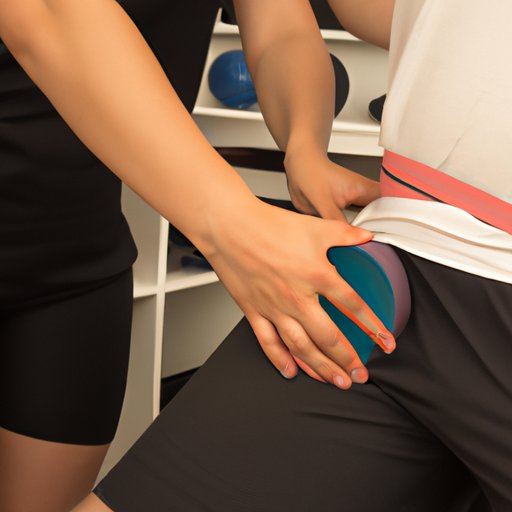
Introduction
Hip pain is a common problem that can interfere with daily activities, sports, and exercise routines, affecting people of all ages and lifestyles. Fortunately, there are many different methods to alleviate hip pain. This article will explore some of the most effective ways to find relief, including exercise, massage therapy, heat and ice therapy, stretching, chiropractic care, acupuncture, and avoiding certain activities.
Hip-Strengthening Exercises
Strengthening the hips is important for pain relief as weak hip muscles can cause poor posture and alignment, putting extra strain on the hip joints. Some of the best hip-strengthening exercises include bridges, clamshells, and squats. Bridges involve lying down on your back and lifting your hips off the ground, squeezing your glutes and tightening your core. Clamshells involve lying on your side with your knees bent and lifting the top knee while keeping your heels together. Squats involve standing with your feet apart and lowering your body towards the ground while keeping your knees in line with your toes.
It’s important to practice these exercises with proper form and increase the intensity gradually. Aim to do each exercise two to three times a week.
Massage Therapy
Massage therapy can be an effective tool for reducing muscle tension and promoting relaxation, which can in turn alleviate hip pain. To target specific areas of hip pain, such as the IT band or hip flexors, it’s important to find a qualified massage therapist who can use the appropriate techniques to release tension and improve circulation.
During a massage session, the therapist will use varying pressure and techniques to work out knots and tension in the muscles. It’s important to communicate any discomfort or pain during the session and to drink plenty of water afterward to flush out toxins.
Heat and Ice Therapy
Heat therapy can promote blood flow and reduce stiffness, while ice therapy can reduce inflammation and numb pain. Alternating between heat and ice therapy is a particularly effective method for relieving hip pain. For heat therapy, try using a heating pad or warm towel for 20 to 30 minutes at a time. For ice therapy, use a cold pack wrapped in a towel for 20 minutes at a time.
It’s important to use heat and ice therapy safely and effectively, as burning or freezing the skin can cause damage. Always place a towel or cloth between the skin and the heat or cold source, and avoid prolonged exposure.
Stretching
Stretching is essential for relieving hip pain and improving flexibility. Some of the best hip stretches include hip flexor stretches, seated figure-four stretches, and butterfly stretches. Aim to hold each stretch for 30 seconds and repeat two to three times on each side.
It’s important to stretch regularly and gradually increase range of motion to avoid injury or strain.
Chiropractic Care
Chiropractic care can be effective for relieving hip pain by aligning the spine and reducing pressure on the hips. Some of the most common chiropractic techniques include spinal manipulation and soft tissue mobilization, both of which aim to improve joint mobility and reduce tension in the muscles.
When looking for a chiropractor, make sure to find a qualified professional with experience in treating hip pain. During a session, the chiropractor will use varying levels of pressure and manipulation to realign the spine and reduce pain.
Acupuncture
Acupuncture is an alternative treatment method that involves inserting tiny needles into specific points on the body to relieve pain and promote relaxation. For reducing hip pain, a licensed acupuncturist can target specific trigger points that can help alleviate tension in the muscles and reduce inflammation.
It’s important to find a qualified acupuncturist and be prepared for a session that may involve deep breathing and a slight pinch upon needle insertion.
Avoiding Certain Activities
Some activities, such as high-impact exercises and sitting for long periods of time, can worsen hip pain. Instead, try swimming, low-impact yoga, or Pilates to get your exercise while putting less stress on your hips. Modifying everyday activities such as using a standing desk can also relieve pressure on the hips.
Conclusion
If you’re experiencing hip pain, there are many different methods for finding relief. This article explored some of the most effective treatments, including hip-strengthening exercises, massage therapy, heat and ice therapy, stretching, chiropractic care, acupuncture, and modifying activities. Remember to always speak with your doctor or healthcare provider before trying any new treatments or exercises. By staying active and incorporating these techniques, you can find relief from hip pain and improve your daily quality of life.




